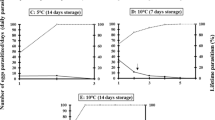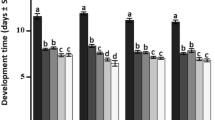Abstract
The use of Trichogramma Westwood (Hymenoptera: Trichogrammatidae) in biological control requires a very large number of insects to be released within an area. The storage of host eggs in liquid nitrogen may represent an alternative method in the mass production of Trichogramma. In order to evaluate the efficacy of egg storage in liquid nitrogen, we examined the parasitism, development and reproduction of Trichogramma pretiosum Riley and Trichogramma atopovirilia Oatman and Platner on eggs of Mythimna sequax Franclemont (Lepidoptera: Noctuidae) stored in liquid nitrogen for 0 (control), 30, 60, or 90 days. Females of each species reared on eggs stored were used to assess their reproductive capacity. The parasitism did not differ between control and cryopreserved treatments. Eggs stored for 60 days had the highest parasitism. The storage of M. sequax eggs in liquid nitrogen was an effective method for the mass production of Trichogramma species.
Similar content being viewed by others
References
Abd El-Gawad HAS, Atef MMS, Ahmed SA (2010) Impact of cold storage temperature and period on performance of Trichogramma evanescens Westwood (Hymenoptera: Trichogrammatidae). Aust J Basic Appl Sci 4:2188–2195
Ayvaz A, Karasu E, Karabörklü S, Tunçbilek AS (2008) Effects of cold storage, rearing temperature, parasitoid age and irradiation on the performance of Trichogramma evanescens Westwod (Hymenoptera: Trichogrammatidae). J Stored Prod Res 44:232–240
Bai B, Luck RF, Forster L, Stephens B (1992) The effect of host size on quality attributes of the egg parasitoid Trichogramma pretiosum. Entomol Exp Appl 64:37–48
Boldt PE, Marston N (1974) Eggs of the greater wax moth as a host for Trichogramma. Biol Control Insects Res 3:545–548
Brotodjojo RRR, Walter GH (2006) Oviposition and reproductive performance of a generalist parasitoid (Trichogramma pretiosum) exposed to host species that differ in their physical characteristics. Biol Control 39:300–312
Chen W-L, Leopold RA, Boetel MA (2008) Cold Storage of Adult Gonatocerus ashmeadi (Hymenoptera: Mymaridae) and effects on maternal and progeny fitness. J Econ Entomol 101:1760–1770
Clausen CP (1939) The effect of host size upon the sex ratio of hymenopterous parasites and its relation to methods of rearing and colonization. J NY Entomol Soc 47:1–9
Dass R, Ram A (1983) Effect of frozen eggs of Corcyra cephalonica Staiton (Pyralidae: Lepidoptera) on parasitism by Trichogramma exiguum (Pinto and Platneri) (Trichogrammatidae: Hymenoptera). Indian J Entomol 45:345–347
Flanders SE (1956) The mechanisms of sex-ratio regulation in the (parasitic) Hymenoptera. Insect sociaux 3:325–334
Foerster MR, Foerster LA (2009) Effects of temperature on the immature development and emergence of five species of Trichogramma. BioControl 54:445–450
Greco CF, Stilinovic D (1998) Parasitization performance of Trichogramma spp. (Hym., Trichogrammatidae) reared on eggs of Sitotroga cerealella Oliver (Lep., Gelechiidae), stored at freezing and subfreezing conditions. J Appl Entomol 122:311–314
Greenberg SM, Nordlund DA, King EG (1996) Mass production of Trichogramma spp.: experience in the former Soviet union, China, United States and western Europe. Biocontrol News Inf 17:51–60
Greenberg SM, Nordlund DA, Wu Z (1998) Influence of rearing host on adult size and ovipositional behavior of mass produced female Trichogramma minutum Riley and Trichogramma pretiosum Riley (Hymenoptera: Trichogrammatidae). Biol Control 11:43–48
Grenier S, Pintureau B, Heddi A, Lassablière F, Jager C, Louis C, Khatchadourian C (1998) Successful horizontal transfer of Walbachia symbionts between Trichogramma wasps. Proc R Soc Lond B 265:1441–1445
Hansen LS, Jensen KMV (2002) Effect of temperature on parasitism and host-feeding of Trichogramma turkestanica (Hymenoptera: Trichogrammatidae) on Ephestia kuehniella (Lepidoptera: Pyralidae). J Econ Entomol 95:50–56
Hohmann CL, Luck RF, Oatman ER (1988) A comparasion of longevity and fecundity of adult Trichogramma platneri (Hymenoptera: Trichogrammatidae) reared from eggs of the cabbage looper and the augumouis grain moth, with and without access to honey. J Econ Entomol 81:1307–1312
Huigens ME (2003) On the evolution of Walbachia-induced parthenogenesis in Trichogramma wasps. Doctoral thesis, Wageningen University, The Netherlands
Huigens ME, Almeida RP, Boons PAH, Luck RF, Stouthamer R (2004) Natural interspecific and intraspecific horizontal transfer of parthenogenesis-inducing Wolbachia in Trichogramma wasps. Proc R Soc Lond B 271:509–515
Jalali SK, Singh SP (1992) Differential response of four Trichogramma species to low temperatures for short term storage. Entomophaga 37:159–165
Jalali SK, Venkatesan T, Murthy KS, Rabindra RJ, Lalitha Y (2007) Vacuum packaging of Corcyra cephalonica (Staiton) eggs to enhance shelf life for parasitization by the egg parasitoid Trichogramma chilonis. Biol Control 41:64–67
Leopold RA (1998) Cold storage of insects: using cryopreservation and dormancy as an aid to mass rearing. In: Area-wide control in insect pests integrating the sterile insect and related nuclear and other techniques. FAO/IAEA Internat. Conf. Penang. Malaysia. June. IAEA-CN-71
Lessard E, Boivin G (2013) Effect of low temperature on emergence, fecundity, longevity and host-feeding by Trichogramma brassicae. BioControl 58:319–329
Li LY (1994) Worldwide use of Trichogramma for biological control on different crops: a survey. In: Wajnberg E, Hassan SA (eds) Biological control with egg parasitoids. CAB Int, Oxon, pp 37–54
Lohmann T, Martinazzo T, Pietrowski F, Kraemer B (2007) Viabilidade do armazenamento de ovos de Anagasta kuehniella, Zeller (Lepidoptera: Pyralidae) em nitrogênio líquido para a produção de Trichogramma pretiosum, riley (Hymenoptera: Trichogrammatidae). Rev Bras Agroecol 2:1551–1555
Lu X, Han S, De Clercq P, Dai J, Li L (2014) Orthogonal array design for optimization of an artificial medium for in vitro rearing of Trichogramma dendrolimi. Entomol Exp Appl 152:52–60
Luck RF, Nunney L, Stouthamer R (1999) Sex ratio and quality in the culturing of parasitic hymenoptera: a genetic and evolutionary perspective. In: Bellows TS, Fisher TTW, Caltagirone LE, Dahlsten DL, Gordh G, Huffaker CB (eds) Handbook of biological control: principles and applications of biological control. Academic Press, San Diego, pp 653–672
Luck RF, Janssen JAM, Pinto JD, Oatman ER (2001) Precise sex allocation, local mate competition, and sex ratio shifts in the parasitoid wasp Trichogramma pretiosum. Behav Ecol Sociobiol 49:311–321
Marchioro CA, Foerster LA (2012) Performance of the wheat armyworm Pseudaletia sequax Franclemont, on natural and artificial diets. Neotrop Entomol 41:288–295
Marston N, Ertle LE (1973) Host influence on the bionomics of Trichogramma minutum. Ann Entomol Soc Am 66:1155–1162
Nadeem S, Ashfaq M, Hamed M, Ahmed S (2010) Optimization of short and long term storage duration for Trichogramma chilonis (Ishii) (Hymenoptera: Trichogrammatidae) at low temperatures. Pakistan J Zool 42:63–67
Nurindah GG, Cribb BW, Gordh G (1999) Influence of rearing host size acceptance by Trichogramma australicum. BioControl 44:129–141
Özder N (2004) Effect of different cold storage periods on parasitization performance of Trichogramma cacoeciae (Hymenoptera: Trichogrammatidae) on eggs of Ephestia kuehniella (Lepidoptera, Pyralidae). Biocontrol Sci Technol 14:441–447
Özder N (2008) Effect of cold storage of adult Trichogramma brassicae, T. cacoeciae and T. evanescens (Hym.: Trichogrammatidae). Arch Phytopathol Plant Protect 41:296–299
Pandey SK (2014) Evaluation of artificial diets for rearing of Corcyra cephalonica (Stainton) for Trichogramma mass production. Ann Biol 30:526–528
Parra JRP, Zucchi RA, Silveira Neto S (1987) Biological control of pests through egg parasitoids of the genera Trichogramma and/or Trichogrammatoidea. Mem Inst Oswaldo Cruz 82:153–160
Pitcher SA, Hoffmann MP, Gardner J, Wright MG, Kuhar TP (2002) Cold storage of Trichogramma ostriniae reared on Sitotroga cerealella eggs. BioControl 47:525–535
Rundle BJ, Thomson LJ, Hoffmann AA (2004) Effects of cold storage on field and laboratory performance of Trichogramma carverae (Hymenoptera: Trichogrammatidae) and the response of three Trichogramma spp. (T. carverae, T. nr. brassicae, and T. funiculatum) to cold. J Econ Entomol 97:213–221
Spínola-Filho PRC, Leite GLD, Soares MA, Alvarenga AC, Paula PD, Tuffi-Santos LD, Zanuncio JC (2014) Effects of duration of cold storage of host eggs on percent parasitism and adult emergence of each of ten Trichogrammatidae (Hymenoptera) species. Fla Entomol 97:14–21
Stinner RE, Ridgway RL, Kinzer RE (1974) Storage, manipulation of emergence, and estimation of numbers of Trichogramma pretiosum. Environ Entomol 3:504–507
St-Onge M, Cormier D, Todorova S, Lucas E (2016) Conservation of Ephestia kuehniella eggs as hosts for Trichogramma ostriniae. J Appl Entomol 140:218–222
Suzuki Y, Iwasa Y (1980) A sex ratio theory of gregarious parasitoids. Res Popul Ecol 22:366–382
Takada Y, Kawamura S, Tanaka T (2001) Host preference of Trichogramma dendrolimi (Hymenoptera: Trichogrammatidae) on its native host, Mamestra brassicae (Lepidoptera: Noctuidae) after 12 continuous generations on a factitious host. Appl Entomol Zool 36:218–231
Tezze AA, Botto EN (2004) Effect of cold storage on the quality of Trichogramma nerudai (Hymenoptera: Trichogrammatidae). Biol Control 30:11–16
van Lenteren JC (2012) The state of commercial augmentative biological control: plenty of natural enemies, but a frustrating lack of uptake. BioControl 57:1–20
van Lenteren JC, Bueno VHP (2003) Augmentative biological control of arthropods in Latin America. BioControl 48:123–139
van Schelt J, Ravensberg WJ (1991) Some aspects on the storage and application of Trichogramma maidis in corn. In: Wajnberg E, Vinson SB (eds) International Symposium on Trichogramma and other egg parasitoids, San Antonio, TX, USA. Les Colloques de 1’INRA 56:239–242
Waage JK, Ming NGS (1984) The reproductive strategy of a parasitic wasp. I. Optimal progeny and sex allocation in Trichogramma evanescens. J Anim Ecol 53:401–415
Wang ZY, He KL, Zhang F, Lu X, Babendreier D (2014) Mass rearing and release of Trichogramma for biological control of insect pests of corn in China. Biol Control 68:136–144
Yilmaz S, Karabörklü S, Ayvaz A (2007) Effect of cold temperature durations on the performance of the adult Trichogramma evanescens (Westwood, 1833) (Hymenoptera: Trichogrammatidae). Türk Entomol Derg 31:269–278
Zhang F, Babendreier Z-Y, Wang KSI, Zheng L, Pyon YC, Bai S-X, Song K, Ri JO, Grossrieder M, Kuhlmann U (2010) Mass releases of Trichogramma ostriniae increase maize production on DPR Korea. J Appl Entomol 134:481–490
Acknowledgments
The authors thank the National Council for Scientific and Technological Development (CNPq) for scholarships and Dr. João Batista Tolentino Jr. for statistical support.
Funding
This study was funded by National Council for Scientific and Technological Development (CNPq) (Grant Number 131168/2008-8).
Author information
Authors and Affiliations
Corresponding author
Ethics declarations
Conflict of Interest
The authors declare that they have no conflict of interest.
Additional information
Handling Editor: Stefano Colazza
Rights and permissions
About this article
Cite this article
da Silva Krechemer, F., Foerster, L.A. Mass production of Trichogramma spp. using Mythimna sequax eggs stored in liquid nitrogen. BioControl 61, 497–505 (2016). https://doi.org/10.1007/s10526-016-9741-4
Received:
Accepted:
Published:
Issue Date:
DOI: https://doi.org/10.1007/s10526-016-9741-4




